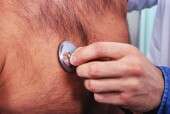Minimal yield seen for routine noninvasive testing for CAD

(HealthDay)—For patients presenting with acute chest pain and low clinical risk evaluated in a chest pain evaluation center (CPEC), the yield of routine noninvasive testing is low for coronary artery disease (CAD), according to a study published in the July 15 issue of The American Journal of Cardiology.
David E. Winchester, M.D., from the University of Florida in Gainesville, and colleagues analyzed data from a prospective cohort of patients who underwent evaluation at a CPEC. Two hundred thirteen patients who presented with normal initial electrocardiogram and cardiac injury markers underwent observation and noninvasive CAD testing at a CPEC.
The patients were young (mean age, 43.8 years), obese (mean body mass index, 30.8 kg/m²), and mainly women (64.8 percent). The researchers found that 11 of the 203 patients who underwent testing had abnormal results, of whom four had obstructive CAD based on invasive coronary angiography. The positive predictive value for obstructive CAD was 45.5 percent after an abnormal test. The overall diagnostic yield for obstructive CAD was 2.5 percent.
"In conclusion, in patients with acute chest pain evaluated in a CPEC, the yield of routine use of noninvasive testing for CAD was minimal and the positive predictive value of an abnormal test was low," the authors write.
More information:
Abstract
Full Text (subscription or payment may be required)
Copyright © 2015 HealthDay. All rights reserved.


















